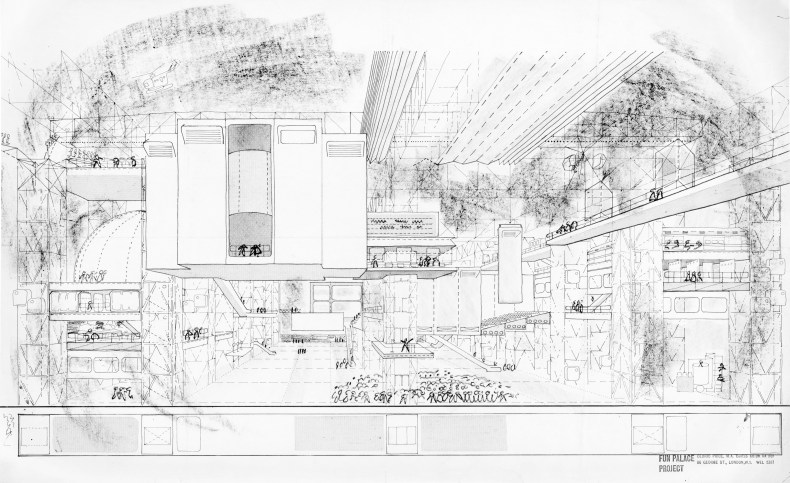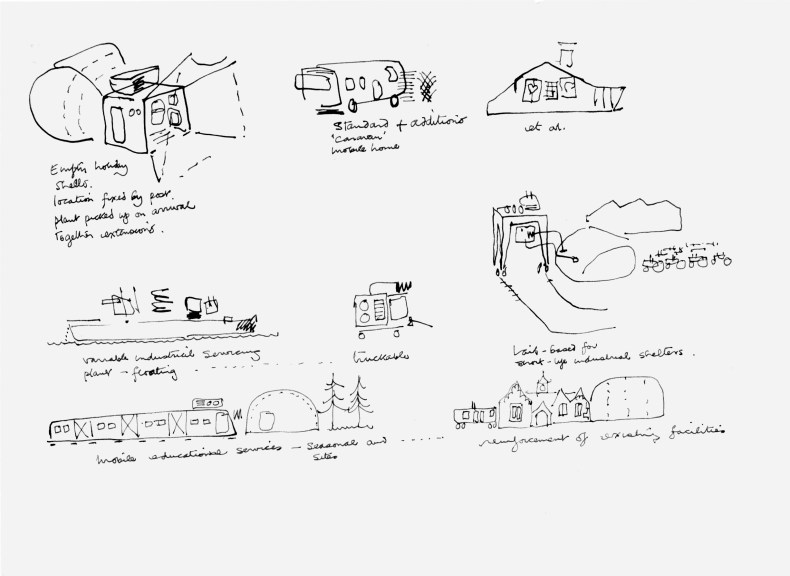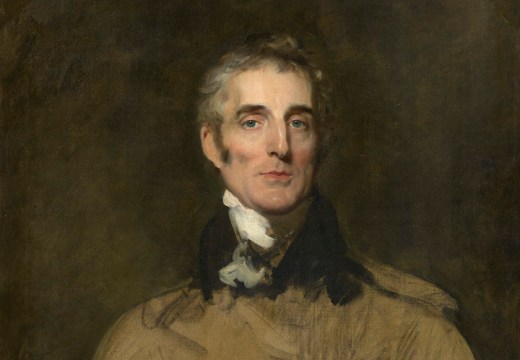Cedric Price (1934–2003) has been described as the most influential architect you have never heard of. Rejecting the weighty, earthbound, and monumental brutalism that was prevalent in the 1960s when Price started practising architecture, he imagined buildings that were lightweight, mobile, and ephemeral. His ideas and images have percolated through architectural culture and beyond, most famously with Price’s Fun Palace providing the visual vocabulary of Renzo Piano and Richard Rogers’ Pompidou Centre. He also radically expanded the role of the architect, bringing a boundless polymathic curiosity to projects, fusing architecture with what turned out to be salient issues, including cybernetics, life-long learning, and information technology. In contrast to much radical avant-garde architecture of the period, notably that of Archigram, Price’s visions were allied to an earnest social consciousness and an awareness of contemporary political issues.

Sketch of the interior of Cedric Price’s (1934–2003) Fun Palace proposal, c. 1964. Courtesy Architectural Association, London and CCA, Montreal; © Estate of Cedric Price
Price died in 2003, and without having been personally acquainted with this mischievous, cigar-smoking, impresario, it has been difficult to get a full understanding of his work on its own terms, rather than through its influence. Even out of a miniscule built oeuvre, little remains that one can see. The only major exception is the ethereally spindly aviary at London Zoo, designed with Lord Snowden and Frank Newby. Price’s projects are buried in various journals and in his large archive, held at the Canadian Centre for Architecture in Montreal. Cedric Price Works 1952–2003: A Forward-Minded Retrospective is therefore hugely welcome.
The book is split into two large volumes. The first presents an account of all of Price’s projects, generously illustrated with archival material. The chronological approach, interspersed with short biographical interludes, results in a rich portrait of both the man and his work. The editor Samantha Hardingham has done a tremendous job in giving authoritative and lucid accounts of each project – not an easy task, as it is an amorphous, frequently perplexing, and occasionally abstruse body of work. The second volume gathers together articles and talks. Price is primarily known for a number of large-scale visionary schemes from the 1960s: the Fun Palace, the Potteries Thinkbelt, Pop-Up Parliament, and Non-Plan. To these we can now add projects on a much smaller scale – such as, of all things, a sheep pen for Tory grandee Alistair McAlpine. We also see him continue to develop his ideas, gloriously oblivious to passing fashions, right up to the late-career summation, Magnet – with each of its 12 structures conceived as ‘a social magnet for information, learning, sanctuary and delight’.
Price described himself as an anti-architect, and his work was meant, at least ostensibly, to be functional to a point where aesthetics was irrelevant. This supposed anti-aestheticism is belied by the illustrations showed here. Appealingly we get a broad range of types of material from the archives to illuminate each project. Cumulatively the models, photomontages, technical details, and a wealth of office ephemera, give a tangible insight into the way Price would approach a brief from multiple angles. Best of all are Price’s cartoonish drawings. He had a beguiling free-hand drawing style, which has the caricaturist’s ability to suggest a lot through a minimum of strokes. The drawings have an ebulliently carefree quality, which gives the sense that one is seeing Price’s ideas in flux. Alongside these visual sources is Price’s prose. Its most notable feature is the frequent use of neologisms, which mix technical jargon with hip phrases and unanticipated archaisms. The result is an oracular, but not charmless, gobbledygook. Price’s use of language is indicative of his defining characteristic: he was a fanatic neophiliac. Everything is to be thought anew, and ends up as a combination of the expandable, the pneumatic, the 24-hour, the portable, the informative, the cybernetic, the multi-membrane, or the disposable.

Cedric Price’s 1968 sketches of vacation homes, industrial plants, and educational services in his Null-Plan scheme, later known as the Non-Plan. Courtesy Architectural Association, London; © Estate of Cedric Price
The planners and architects of the 1960s are often criticised for giving up on tradition. Price attacked them from the opposite side, seeing the architectural production of the period as little better than the Middle Ages with electricity. There is surely a degree of waggish épater la bourgeoisie in Price’s assertion that Britain’s cathedrals ought to be demolished (or at the very least turned into family planning centres), nevertheless in the Pop-Up Parliament scheme, Barry and Pugin’s Palace of Westminster was seen as an anachronism, as ‘permanence isn’t the thing to symbolise in an era of throwaway Pentel pens and planned obsolescence’. Such talk looks increasingly crass and irresponsible. Furthermore, I suspect that the constant exhortation to have fun found in Price’s hyperkinetic audio-visual bonanzas would very quickly not be fun at all.
If extended acquaintance with Price’s ideas elicits a priggish exhaustion, there are also many moments when his exuberant, outlandish thinking is undeniably thrilling, giving the sense that there are limitless possibilities to change the world for the better if only we change our perspective. My favourite of his suggestions is the 1984 proposal to distribute the entirety of J.M.W. Turner’s paintings around British Rail’s stock, both in stations and in specially designed gallery carriages, where they could be taken on tours around the landscapes they depicted. Price said, ‘it would be the largest gallery in the world, not only enhancing the interest of the stations but enabling every member of the public who travelled with BR a trouble-free opportunity to see the rare and the wonderful.’ This is indicative of Price at his most democratic, iconoclastic, and delightful.
From the March 2017 issue of Apollo. Subscribe here.
Unlimited access from just $16 every 3 months
Subscribe to get unlimited and exclusive access to the top art stories, interviews and exhibition reviews.














![Masterpiece [Re]discovery 2022. Photo: Ben Fisher Photography, courtesy of Masterpiece London](http://www.apollo-magazine.com/wp-content/uploads/2022/07/MPL2022_4263.jpg)
Why are fathers so absent from art history?